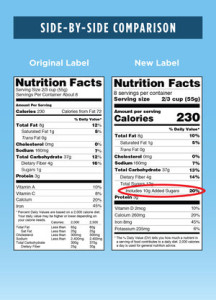Navigating the New Sugars Added Label Requirements
The FDA recently announced changes to the Nutrition Facts label, with more details about sugar. Starting in 2018 [1], the FDA will require Nutrition Facts labels to distinguish between sugars found naturally in ingredients and sugars added, both in grams and a percentage of daily recommended value. The FDA is recommending no more than ten percent of calories come from added sugar. Because the label will not include a daily percentage value for the total grams of sugar, the FDA is drawing a clear line between sugars based on their origins. This means consumers will know—and quickly judge—products based partly on the new sugars added label.
Here’s an overview of the new sugars added label requirements and definitions:
- The definition of added sugars includes sugars that are either added during the processing of foods, or are packaged as such.
- Added sugars will include syrups such as honey and maple syrup.
- Added sugars include fruit concentrate, but not in every case.
What the New Sugars Added Label Means for Consumers

These new sugars added label requirements represent a microscopic, but telling shift from the “what” to the “how.” They reflect profound consumer interest in knowing more about food’s journey across the entire supply chain. Instead of simply updating the back label as required, take the opportunity inherent in this moment to further educate your customers. The most appropriate education, will of course, depend on your brand strategy; no matter how you approach your messaging and customer education, make sure it aligns with your brand, while empowering people to make informed decisions. Here are three possible approaches.
1. Show Your Work to Reduce Added Sugars
For some companies, the new label requirements fall in line with existing efforts to refine processes and products. While some organizations advocated against dividing sugars on the back label, Nestlé made an emphatic statement in support of it. This is not surprising, because Nestlé has invested heavily in reducing adding sugar, even restructuring sugar at the molecular level. Other companies may turn to fruit products for both sweetness and function, to achieve an optimal balance between the sugars and sugars added lines on the label. If you’re already working to reduce added sugars, showcase these efforts. It makes the narrative more about your product and appealing ingredients than about basic legal requirements.
2. Embrace Transparency
It’s understandable that some companies are worried about the new label decreasing their appeal to customers. The new label doesn’t change the total number of sugars in products, but it pulls the curtain back and tells people which ones are inherent in ingredients. People want to know more about how their food is made, where ingredients come from, and about the processing that takes place. Make this information free and plentiful so that the back label isn’t the only place to find this information. In the absence of other information, people are likely to draw their own conclusions about the sugar added. Give them all the facts they need to evaluate this information so the label doesn’t surprise them. By incorporating transparency into your brand, it sets a reassuring tone and lets people know you have nothing to hide.
3. Put the Spotlight on Your Ingredients
The new sugars added label will give your customers a number, a quantitative fact. Expand on this. Use your messaging and story to explain what goes into that number, as well as what your product includes, beyond sugars. If your brand centers on natural ingredients, such as honey, consider the most effective way to include or highlight this fact. This opportunity is even more pronounced if your brand can include specific information about the location or source of the honey. Show people that they deserve to know what’s in their food and that you’re proud of the answer.
Your brand is more than the sum of sugars on the Nutrition Facts label. As your company considers how to best increase education according to your brand, honestly consider whether your brand is everything it could be. Our deep expertise in the food industry gives us unique insight into crafting brand stories that can keep up with the evolution of the food industry. Call or email us today to learn how we can help your brand tell its story amidst changing regulations.
[1] Companies with less than $10 million in annual sales will have until July 2019.
